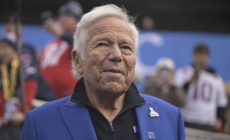-
Patriots Owner Robert Kraft Once Again Denied Induction into Hall of Fame - 9 mins ago
-
The Alluring Dream That Black America Needs to Wake Up From - 10 mins ago
-
Brooke Shields’ 2-Word Nickname for George H. W. Bush - 45 mins ago
-
The Secret Behind America’s Moral Panic - 55 mins ago
-
Ex-Congressman on Bondi Pick: Bag of Peanut Butter Is ‘Better Than Gaetz’ - about 1 hour ago
-
Chuck Scarborough to Step Down as WNBC News Anchor After 50-Year Career - 2 hours ago
-
‘Wordle’ Today #1,252 Answer, Hints and Clues for Friday, November 22 - 2 hours ago
-
The UK Faces a Dilemma: Cozy Up to Trump or Reconnect With Europe? - 2 hours ago
-
NYT ‘Connections’ November 22: Clues and Answers for Game #530 - 3 hours ago
-
Bob Casey Concedes to David McCormick in Pennsylvania Senate Race - 3 hours ago
Putin Faces Major Dilemma Over Dwindling Manpower
More than two and a half years into what Russian President Vladimir Putin had hoped would be a days-long war, Russia—and indeed, Ukraine—will need to source fresh manpower for grinding operations, with little hope of an end to the conflict in sight.
According to Ukraine’s numbers, Moscow has sustained more than 665,000 casualties since February 2022, including more than 1,000 soldiers killed or injured between Wednesday and early Thursday.
Russia does not provide a running tally of Ukrainian casualties, but regularly reports that more than 1,000 of Kyiv’s fighters have been killed or injured each day.
It is notoriously difficult to verify battlefield casualties, especially when looking at figures put forward by a party involved in the conflict. However, the British government said on Monday that Moscow had likely sustained 648,000 casualties, a figure falling just below Ukraine’s count.
“Both Russia and Ukraine have been facing serious problems with personnel numbers,” said William Freer, a research fellow in national security at the U.K.-based think tank, the Council on Geostrategy.
“After the supply of ammunition, replacing casualties is the second most important aspect for both sides in winning a war of attrition,” Freer told Newsweek.

Newsweek Illustration/Canva
September marked the highest number of Russian casualties reported in a single month, the U.K. Defense Ministry said this week. The Kremlin will likely carry on sustaining more than 1,000 casualties each day in Ukraine for the rest of the year, despite the onset of winter, London said.
With no let up on the horizon, Russia may soon have to look for ways to refill its ranks, propping up what have become known as “meat-grinder” assaults on Ukrainian defensive positions in the east. Moscow has slowly but steadily advanced in eastern Ukraine throughout the year, relying on personnel-heavy attacks with high casualty counts.
With several options on the table, Russia likely hopes to make joining up voluntarily attractive enough to reel in fresh recruits, but does have the more unpopular options of sending conscripts to Ukraine or green-lighting a new wave of mobilization to fall back on.
How Does Russia Source Personnel?
Russia pulls together its military from a number of sources. The majority are conscripted, serving typically around a year, but Moscow also gets a significant chunk of personnel signing up to contracts with the ministry of defense. The Kremlin also has access to reservists, which can be mobilized when needed.
Moscow has used separatists in eastern Ukraine, forces from the Russian republic of Chechnya, which is led by firm Putin ally Ramzan Kadyrov, and mercenary fighters like those belonging to the Wagner Group to fill out its fighting ranks.
Convicts incarcerated in Russia, or those otherwise sent to what are known as “punishment units” or “Storm-Z” squads, have been heavily involved in fighting.
Russia has also had foreign nationals join up to fight on its behalf, offering what may be seen as competitive salaries and Russian citizenship.
Conscription
Russia has long had two yearly drafts, the first in spring and then another during the fall. The latest started on October 1, and Putin said 133,000 new personnel between 18 and 30 years old would be drafted in this call-up. The Kremlin raised the upper age limit from 27 years old in summer 2023.
Those conscripted serve for a year in military units inside Russia, and law dictates they will not be sent to Ukraine.
But up to 1 million Russians “have fled the country, many of ‘fighting age’ explicitly to avoid military service,” said Freer. “Russia’s recruiting pool therefore is significantly reduced.”
Russian authorities changed the conscription process last year, making it possible for call-up papers to be served electronically. This was widely seen as an effort to crack down on draft-dodging.
The main idea around conscription is to have fighters trained for defense, should Russia be invaded, said Mark Cancian, a retired U.S. Marine Corps Reserve colonel and a senior adviser with the U.S. think tank, the Center for Strategic and International Studies.
Contract Fighters
Another major chunk of recruits come from what are known as contract soldiers, who typically serve a multiple-year stint in the military and are often responsible for training the conscripted personnel.
Last month, Russian independent outlet iStories reported that Moscow had allocated 90 billion rubles, around $926,000,000, for three years’ worth of one-off payments for the signing of contract soldiers. This would be enough to recruit an additional 225,000 contract soldiers in that time, according to the report.
Andriy Kovalenko, an official with Ukraine’s National Security and Defense Council, referred earlier this week to these figures, saying they indicated Russia intends “not to carry out mobilization.”
Reservists and Mobilization
Russia also has reservists, or former soldiers who are kept on record and can be called upon if needed. When Moscow declared a partial mobilization in September 2022—the only such action the Kremlin has put into place throughout the full-scale war—Russian authorities said only reservists would be called up.
“These are not people who’ve never seen or heard anything about the army,” said then Defense Minister Sergei Shoigu.
The 300,000 mobilized personnel would receive extra training specific to Ukraine before heading off, Putin said at the time. The weeks following the mobilization announcement were chaotic, and prompted many Russians to leave the country.
In October 2022, a report by two Russian investigative outlets found that mobilization was hitting different regions to varying extents, and that “the poorer the people [who] live in a region, the more it was affected by mobilization.”
“Recruitment has so far targeted poorer families and those from ethnic minorities,” said Freer. “This has faced some pushback, but the Russian state has so far proved highly effective at minimizing any instability through harsh repression.”
But as casualties mount, said Freer, the Kremlin could “soon be forced to look for new cohorts to recruit from, which could face more serious political pushback.”
The Russian president may also find himself needing to recruit from the wealthier or more powerful regions and circles, Freer said, which could then compound political dissidence.
The Dilemma
Faced with a need to bolster its manpower, experts say, Russia will want to rely on nudging volunteers toward recruitment offices rather than go down the more politically dicey routes of mobilization or sending conscripts to Ukraine.
In mid-September, Russian independent investigative outlet Meduza reported that as recruitment of volunteers had slowed, the Kremlin had “more than doubled” the incentive offered across the board for potential new contract fighters to sign up. The financial encouragement went up from the equivalent of $2,121 to $4,350.
Although unlikely to sign up in large numbers, attracting foreign fighters to Russia’s military ranks with financial incentives and the lure of citizenship after a stint of fighting in Ukraine is a politically appealing form of recruitment for Moscow, added Cancian.
“Putin has attempted a ‘covert’ mobilization through increasingly desperate measures of increasing incentives and reducing requirements, but this will only suffice for a limited time,” said Freer. “It is to some extent being supplemented by targeting foreign nationals.”
A mobilization in the style of fall 2022 would have a “huge impact” on Putin’s personal reputation, said Andrii Ziuz, former chief executive of Ukraine’s National Security and Defense Council who now heads the technology division of London-based company, Prevail.
Sanctions leveled against Moscow have been ineffective, he told Newsweek, “which gives them a certain financial maneuver to increase cash incentives.”
Should Putin decide that conscripts are needed in Ukraine, he would have to appeal to Russian lawmakers to change current legislation, Cancian told Newsweek. “
He may also argue that Crimea, for example, is part of Russia, Cancian said. One hypothetical is that Moscow could send conscripts to man systems like air defenses away from the front line
Conscripts can already fight in Kursk, the Russian region bordering Ukraine where Moscow has been battling back Kyiv’s surprise incursion for just over two months, Cancian added.
Private military companies, such as the Wagner Group, had a major role in fighting earlier in the war, and were key in Russia’s capture of the eastern Ukrainian city of Bakhmut in May 2023.
But in June 2023, a number of Wagner fighters mutinied against Moscow in a brief but dramatic challenge to the Kremlin. Shortly after, the paramilitary group’s outspoken leader, Yevgeny Prigozhin, and several other prominent Wagner commanders were killed in a plane crash in Russia. The group in its previous form has largely dispersed, still present but often absorbed elsewhere or under new leadership.
“The various private military groups have been brought under more direct control,” said Freer.
“They’re less prominent, now that Wagner has been brought to heel,” Cancian added. “They’re not as visible, and I think the numbers are probably not as great.”
Ukraine’s Recruitment
Russia’s issues gathering new personnel are reflected in Ukraine, too. “The basic problem that the Russians are facing is the same problem everyone faces in a protracted conflict,” said Cancian.
In April this year, Ukraine lowed its draft age from 27 to 25.
Kyiv has a smaller pool of potential recruits than Russia, and its foreign fighters are dwarfed by Russia’s Chechen forces, Cancian added. It’s also a demoralizing prospect to be recruiting when your forces are on the defensive, he added, as Ukraine currently is in the face of Russian advances in the east.
Yet there is a “very different motivation,” Cancian added. Ukrainians are defending their homeland, which Russia’s forces deployed in Ukraine cannot relate to. Kyiv also has a hand-up with logistics from its allies, he said.
Ultimately, unless Moscow eases up on its offensive operations, “at some point in the next couple of months, the Russians are going to have to make a decision about what they’re planning to do,” Cancian said.
Source link





















